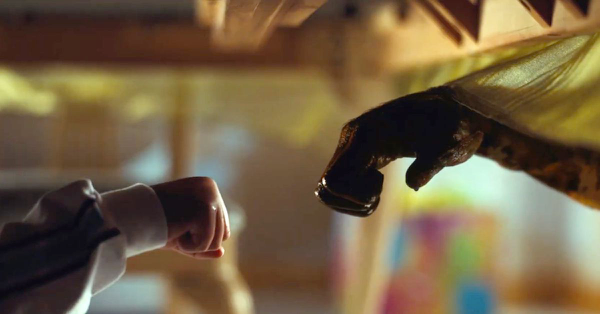Movie review by Greg Carlson
In addition to boasting one of the year’s best titles, Jordan Peele’s mind- and genre-bending mash-up “Nope” is big and bold and willing to take risks, even if those wild gambits don’t always pay dividends. The filmmaker’s third feature as writer/producer/director pokes and prods at all kinds of fascinating text and subtext, once again suggesting that there is much more to his stories than what may only be observable on a superficial level. Experimenting with science fiction and the classic Hollywood Western without abandoning some of the horror and suspense that fueled “Get Out” and “Us,” Peele extends and expands upon his interest in historical and institutional racism.
Fictionally linked to the pioneering motion studies made by Eadweard Muybridge, Haywood’s Hollywood Horses owners O.J. (Daniel Kaluuya) and Emerald (Keke Palmer) aren’t exactly on the same page following the bizarre death of patriarch Otis Sr. (Keith David). Under financial duress, O.J. reluctantly makes an arrangement to sell some of his beloved animals to nearby entrepreneur and one-time kid actor Ricky “Jupe” Park (played as an adult by Steven Yeun and shown in flashback as a child portrayed by Jacob Kim), who runs an old-fashioned Wild West-themed carnival/fun fair called Jupiter’s Claim.
As a veteran of the entertainment industry, Peele is well-positioned to riff on the old adage that there’s no business like show business, and many observers have zeroed in on the ways in which “Nope” is a multi-layered critique of generational trauma and erasure inflicted by Hollywood on marginalized and underrepresented people as well as a rich exploration of the photographic process and the relationship between the viewer, the camera eye, and the things being observed. One of Peele’s central gimmicks is the Shyamalan-esque in-universe rule that making eye contact puts humans in harm’s way.
Some viewers and critics have griped that “Nope” fails to establish the kind of rich interpersonal relationship markers and detailed characterizations that would be expected in just this sort of “blockbuster” experience – think Spielberg’s magic touch with Brody, Hooper and Quint in “Jaws,” for example. But on closer inspection, the elision appears to be as deliberate a choice as the initially curious absence of local, state, or federal authorities who would, in movies across the decades, be overwhelmingly portrayed as white and male and in charge. Without compromising what ticket buyers expect as entertainment, Peele asks us to think about who and what is present.
One of the most refreshing dimensions of “Nope” resides in Peele’s willingness to trust viewers to follow him into unexpected territory. Even though the filmmaker organizes a narrative baseline – a UFO hiding in the clouds – the horrifying anecdote of “trained” sitcom performer Gordy the chimpanzee’s inexplicable attack on his co-stars during a routine production is an apparent side-trip that turns out to link the movie’s parallel stories. Jupe describes his almost unbelievable ordeal as “six and a half minutes of havoc” as Peele rhymes the past and present, pondering the public appetite for violence as processed through lenses large and small.
